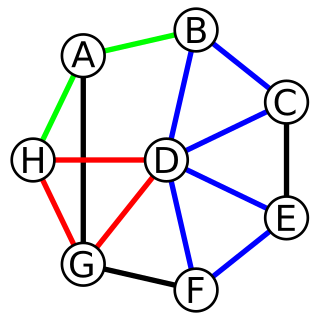There are many terms in mathematics that begin with cyclic:
- Cyclic chain rule, for derivatives, used in thermodynamics
- Cyclic code, linear codes closed under cyclic permutations
- Cyclic convolution, a method of combining periodic functions
- Cycle decomposition (graph theory)
- Cycle decomposition (group theory)
- Cyclic extension, a field extension with cyclic Galois group
- Graph theory:
- Cycle graph, a connected, 2-regular graph
- Cycle graph (algebra), a diagram representing the cycles determined by taking powers of group elements
- Circulant graph, a graph with cyclic symmetry
- Cycle (graph theory), a nontrivial path in some graph from a node to itself
- Cyclic graph, a graph containing at least one graph cycle
In group theory, a sub-field of abstract algebra, a group cycle graph illustrates the various cycles of a group and is particularly useful in visualizing the structure of small finite groups.

In graph theory, a circulant graph is an undirected graph acted on by a cyclic group of symmetries which takes any vertex to any other vertex. It is sometimes called a cyclic graph, but this term also is given other meanings.

In graph theory, a cycle is a path of edges and vertices wherein a vertex is reachable from itself. There are several different types of cycles, principally a closed walk and a simple cycle; also, e.g., an element of the cycle space of the graph. If a graph contains no cycles it is referred to as being acyclic.
- Cyclic group, a group generated by a single element
- Cyclic homology, an approximation of K-theory used in non-commutative differential geometry
- Cyclic module, a module generated by a single element
- Cyclic notation, a way of writing permutations
- Cyclic number, a number such that cyclic permutations of the digits are successive multiples of the number
- Cyclic order, a ternary relation defining a way to arrange a set of objects in a circle
- Cyclic permutation, a permutation with one nontrivial orbit
- Cyclic polygon, a polygon which can be given a circumscribed circle
- Cyclic shift, also known as circular shift
- Cyclic symmetry, n-fold rotational symmetry of 3-dimensional space

In coding theory, a cyclic code is a block code, where the circular shifts of each codeword gives another word that belongs to the code. They are error-correcting codes that have algebraic properties that are convenient for efficient error detection and correction.
In graph theory, a cycle decomposition is a decomposition into cycles. Every vertex in a graph that has a cycle decomposition must have even degree.

In graph theory, a cycle graph or circular graph is a graph that consists of a single cycle, or in other words, some number of vertices connected in a closed chain. The cycle graph with n vertices is called Cn. The number of vertices in Cn equals the number of edges, and every vertex has degree 2; that is, every vertex has exactly two edges incident with it.





